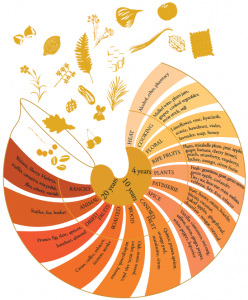Armagnac Aromas Depicted in a Seashell
 For many years we have been using a very impressive aroma wheel, set up by the BNIC, to help us describe the different aromas detected in cognac. I suppose it was inevitable that the Armagnaҫais would come up with something similar. So, instead of a wheel, armagnac aromas have been described in a round seashell with a collection of fruit, herbs, nuts and flowers floating mysteriously from the shell aperture. There are a number of other surprises too since the shell is split into three sections. The inner section denotes a range of ages, 4, 10 and 20 years, and linked to each a number of general types of aroma such as heat, cooking, plants, woods, animal and rancio. The outer section lists detailed aromas associated with each. Some are familiar smells such as dates, cedar, cinnamon and plums but those of ether, pharmacy, soap, resin, sap, stables and varnish are much less appealing. I’m not sure how much I would be tempted to taste an armagnac exhibiting any of these aromas!
For many years we have been using a very impressive aroma wheel, set up by the BNIC, to help us describe the different aromas detected in cognac. I suppose it was inevitable that the Armagnaҫais would come up with something similar. So, instead of a wheel, armagnac aromas have been described in a round seashell with a collection of fruit, herbs, nuts and flowers floating mysteriously from the shell aperture. There are a number of other surprises too since the shell is split into three sections. The inner section denotes a range of ages, 4, 10 and 20 years, and linked to each a number of general types of aroma such as heat, cooking, plants, woods, animal and rancio. The outer section lists detailed aromas associated with each. Some are familiar smells such as dates, cedar, cinnamon and plums but those of ether, pharmacy, soap, resin, sap, stables and varnish are much less appealing. I’m not sure how much I would be tempted to taste an armagnac exhibiting any of these aromas!
Even more surprisingly, the chart seems to suggest that certain aromas are linked to armagnac ages. Prune is perhaps the most common aroma and taste found in armagnac but it only appears on the chart alongside the oldest. The concept is good, but come on BNIA, you can do better than this.
